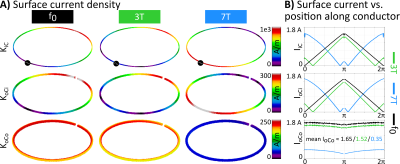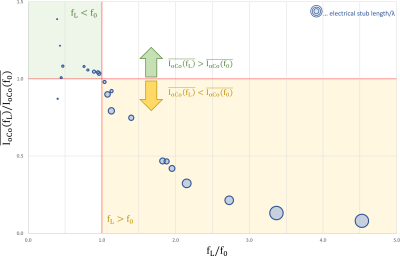Sigrun Roat1, Andre Kuehne2, Lena Nohava1,3, and Elmar Laistler1
1High Field MR Center, Center for Medical Physics and Biomedical Engineering, Medical University of Vienna, Vienna, Austria, 2MRI.TOOLS GmbH, Berlin, Germany, 3CEA, CNRS, Inserm, BioMaps (Laboratoire d'Imagerie Biomédicale Multimodale Paris Saclay), Université Paris-Saclay, Orsay, France
1High Field MR Center, Center for Medical Physics and Biomedical Engineering, Medical University of Vienna, Vienna, Austria, 2MRI.TOOLS GmbH, Berlin, Germany, 3CEA, CNRS, Inserm, BioMaps (Laboratoire d'Imagerie Biomédicale Multimodale Paris Saclay), Université Paris-Saclay, Orsay, France
Our simulations show
that it is advantageous to operate the coil close to their self-resonance
frequency. This might be achieved by changing the size of the coil or introducing
additional gaps in order to shift the self-resonance.

Fig. 1A) Surface
current density plots for the coil setup A1 (100 mm diameter) evaluated at
frequencies for 3T (top) and 7T (middle) MR as well as at its f0
(109 MHz, bottom) on the three substructures iC, oCi and oCo. B) shows the
corresponding surface current plots for all three frequencies (3T, 7T and f0
in green, blue and black, respectively) on the aforementioned substructures.

Fig. 2 Simulation
results for all setups. Ratio of the mean surface current at the operating
(Larmor) frequency over at self resonance plotted against the deviation from
the self-resonance fL/f0. The size of each data point is
proportional to the electrical stub length over the wavelength in the cable.
